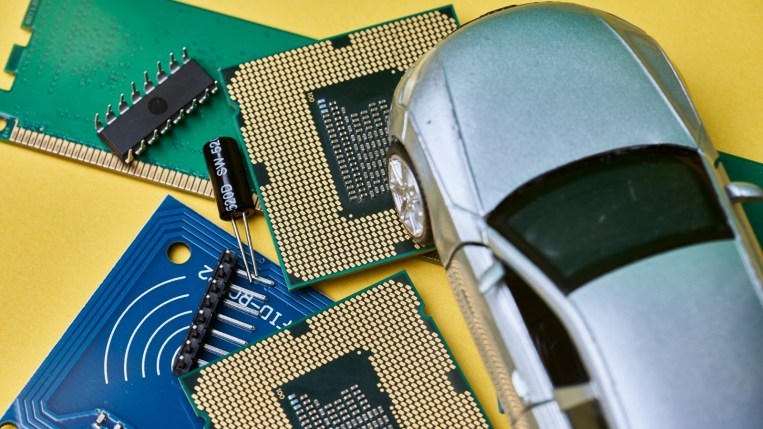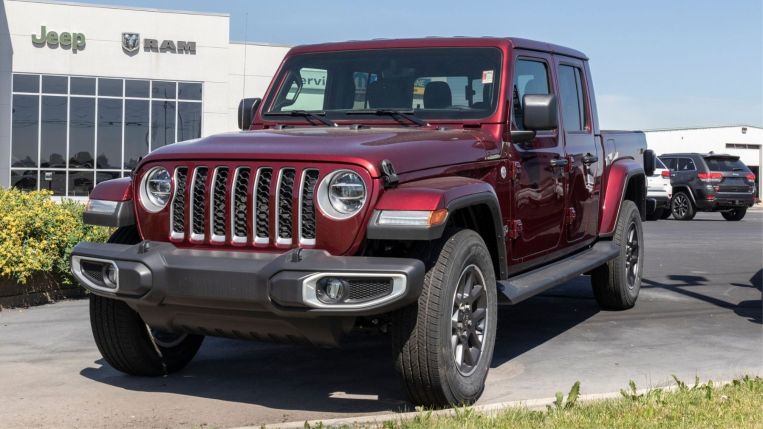
Car shopping? If you’re reading this article during the global chip shortage, we want to walk you through some steps you can take to find the vehicle of your dreams.
Simply put, there has never been a worse time to buy a new or used car. A perfect storm of factors pushed car prices to record highs and reduced the number of vehicles available for sale. You will find a slim selection of cars and the highest new and used prices.
The conditions that created this challenging market for buying a car may be with us through much of 2022.
That’s why you’ll need this advice to help you navigate the crisis.
Best Ways to Shop for a Car Right Now

How? We’ll tell you nearly a dozen ways to shop for a vehicle so you can score the best deal you can, even in a challenging market.
1. Wait, Even if it’s Painful
The first tip is the simplest – want to save money on a new car right now? Don’t buy one.
The market will normalize. Most experts expect the microchip shortage to ease in the second half of 2022. Prices will begin to come down at that point.
So, fixing your old car should be your first option.
Conventional wisdom tells drivers that there comes the point when putting new parts into an aging car is counterproductive. Something more expensive is always about to break. But the economists at Kelley Blue Book parent company Cox Automotive say the average new car payment in December was a whopping $688 per month. At that rate, stretching just a few more months out of your old car can save you thousands of dollars and give you the chance to wait for prices to calm down.
2. Know What You’re Getting Into During the Shortage
If you must buy, arm yourself with knowledge. Know that new car prices aren’t just at an all-time high — they’ve set a new record every month for the past nine months. Meanwhile, incentives are at a 20-year low. In November 2020, the average buyer paid almost $3,000 below the sticker price. In December 2021, the average non-luxury car buyer paid $900 over sticker. Luxury car shoppers had it worse. On average, they paid $1,300 above MSRP during the chip shortage.
3. Be Realistic About Your Needs
Americans consistently make a costly mistake when car shopping — we buy impractical vehicles for everyday use. For example, a buyer might purchase 7-seaters thinking about how family comes to visit one to two weeks a year and then only use the three rows of seating to carry the whole family those days but not the rest of the year.
Or you might spend thousands of dollars extra on all-wheel drive (AWD) because it occasionally snows in your area.
Why not buy a 2-row vehicle, and rent a car when the folks come? Why not work from home on snow days, if possible? Better yet, why not get a cheap set of snow tires instead of AWD?
RELATED STORIES: Best Cars and SUVs for Snow: Features You Need
4. Shop Outside Your Usual Segment
Consider switching to a different vehicle category with more realistic needs in mind. Americans bought more SUVs than cars and trucks combined in 2021. Dealers have more large cars for sale today than they do any other type of vehicle. You’re more likely to negotiate a good deal on a sedan because of simple supply and demand. A large sedan can carry nearly as much as an SUV and is often more fun to drive.
5. Consider a Different Brand
News stories have touted a thin supply of new cars for more than a year. But the chip shortage did not affect every dealership in the same fashion.
Some brands faced shortages of new vehicles to sell. In December, Toyota dealerships had just 20 days’ worth of cars on sales lots. The story was the same at Kia dealerships. Honda dealers averaged 21 days of inventory.
Alfa Romeo dealerships, however, had a 103-day supply. Dodge dealers had 72. Jeep dealers had three times as much inventory as Toyota dealers.
Our ideas about which brands build high-quality cars are often out of date. Quality and dependability studies tend to show that most new vehicles today are well-built, with only a slight difference between manufacturers.
6. Consider a Lease as a Temporary Solution
If brand loyalty is essential to you, this year might be the right time to shift your allegiance temporarily. If you’re a lifelong BMW fan but can’t find the BMW you want amid the chip shortage, consider taking out a lease on another brand. You can always buy the Bimmer later when supplies return to normal.
Leases come with mileage restrictions. But many of us are driving fewer miles than ever before during the COVID-19 pandemic. You might find it easy to keep to the terms of a lease.
RELATED: Average Miles Driven Per Year: Why It Is Important
7. Shop Outside Your Area
If we offered to pay you $2,000 to drive to a nearby town and back, you’d probably take it. So why not go to a nearby city and back to save $2,000?
Under normal circumstances, dealerships can trade with one another. That makes it relatively easy for your local dealer to sell you a car that’s sitting on another dealer’s lot and arrange for delivery. But, with every dealership low on vehicles to sell, those trades are rarer this year. So use the manufacturer’s website to locate a car you want, even if it’s not nearby, and travel to pick it up.
RELATED: How to Buy a Car Online
Note that shopping outside your state can make taxes and registration slightly more complicated, but most dealerships should be able to help you with an out-of-state purchase.
8. Boost Your Buying Power with Your Trade-in
When used cars are in good supply, any two dealerships will likely offer you a similar amount for your trade-in. In this market, that isn’t always true. Dealerships try to keep a good mix of used cars available for sale, and one might value your trade-in more than another. You can sell your vehicle to one dealership and use that money to buy from another.
So, call and shop your trade-in around so you can score the highest price. It can add steps, but the savings will be worth it.
TIP: Try our Instant Cash Offer tool and let the deal make its way to your email inbox. You fill in the details of your car and dealerships come to you with offers that you can take or leave as you wish.
9. Be Flexible on Color and Options During New Car Shortage
When new cars are in plentiful supply, being picky about the color and options you want is easy. With new vehicles in short supply, you might not find the exact model you want. Being flexible and accepting a different color or a few options you might not use makes all the difference in finding a vehicle.
You might even surprise yourself. One of our editors “settled” for an orange car once, only to discover a secret society of orange car owners who honk and wave at each other in traffic.
10. Can’t Negotiate on Price? Negotiate on Financing
When negotiating the price of a new car, you’re better off focusing on the out-the-door price than the monthly payment. But, in this climate, many dealers aren’t flexible with prices. They know that if you don’t buy the car, someone else will soon.
They can, however, negotiate the terms of financing. Savvy buyers qualify for outside funding before they go to the dealership. But you can always ask the dealer to try to beat your bank’s loan offer.
11. Consider Ordering – But Get it in Writing
Car-buying Americans like driving their new car off the lot the day they purchase it, not several months later. In Europe, car shopping rarely works that way. Most European car shoppers order the precise car they want first, and only then does the car’s production begin.
The American auto industry is steadily becoming more like the European industry, with buyers ordering the car they want and delivering later. If you can wait, it might make sense to custom order and put up with the wait for your new vehicle. Just be sure to get the deal in writing.
A Shortage of Ethics
For any car buying deal you agree to, get the final and firm price in writing with the dealer’s signature on the contract. Many dealer salespeople operate ethically. But chip shortages and inventory issues make unethical price gouging more common.
Both Ford and General Motors recently warned their dealerships to cut out sketchy markups. A signed purchase agreement protects you from any last-minute price inflation. Question any and all fees on the bottom line and report issues directly to the carmakers if you suspect price gouging.
Related Car Buying Stories
- How to Buy a New Car in 10 Steps
- When Will the Chip Shortage End?
- Chip Shortage Continues to Hurt Sales in Otherwise Hot Market
Car shopping? If you’re reading this article during the global chip shortage, we want to walk you through some steps you can take to find the vehicle of your dreams.
Simply put, there has never been a worse time to buy a new or used car. A perfect storm of factors pushed car prices to record highs and reduced the number of vehicles available for sale. You will find a slim selection of cars and the highest new and used prices.
The conditions that created this challenging market for buying a car may be with us through much of 2022.
That’s why you’ll need this advice to help you navigate the crisis.
How? We’ll tell you nearly a dozen ways to shop for a vehicle so you can score the best deal you can, even in a challenging market.
The first tip is the simplest – want to save money on a new car right now? Don’t buy one.
The market will normalize. Most experts expect the microchip shortage to ease in the second half of 2022. Prices will begin to come down at that point.
So, fixing your old car should be your first option.
Conventional wisdom tells drivers that there comes the point when putting new parts into an aging car is counterproductive. Something more expensive is always about to break. But the economists at Kelley Blue Book parent company Cox Automotive say the average new car payment in December was a whopping $688 per month. At that rate, stretching just a few more months out of your old car can save you thousands of dollars and give you the chance to wait for prices to calm down.
If you must buy, arm yourself with knowledge. Know that new car prices aren’t just at an all-time high — they’ve set a new record every month for the past nine months. Meanwhile, incentives are at a 20-year low. In November 2020, the average buyer paid almost $3,000 below the sticker price. In December 2021, the average non-luxury car buyer paid $900 over sticker. Luxury car shoppers had it worse. On average, they paid $1,300 above MSRP during the chip shortage.
Americans consistently make a costly mistake when car shopping — we buy impractical vehicles for everyday use. For example, a buyer might purchase 7-seaters thinking about how family comes to visit one to two weeks a year and then only use the three rows of seating to carry the whole family those days but not the rest of the year.
Or you might spend thousands of dollars extra on all-wheel drive (AWD) because it occasionally snows in your area.
Why not buy a 2-row vehicle, and rent a car when the folks come? Why not work from home on snow days, if possible? Better yet, why not get a cheap set of snow tires instead of AWD?
RELATED STORIES: Best Cars and SUVs for Snow: Features You Need
4. Shop Outside Your Usual Segment
Consider switching to a different vehicle category with more realistic needs in mind. Americans bought more SUVs than cars and trucks combined in 2021. Dealers have more large cars for sale today than they do any other type of vehicle. You’re more likely to negotiate a good deal on a sedan because of simple supply and demand. A large sedan can carry nearly as much as an SUV and is often more fun to drive.
News stories have touted a thin supply of new cars for more than a year. But the chip shortage did not affect every dealership in the same fashion.
Some brands faced shortages of new vehicles to sell. In December, Toyota dealerships had just 20 days’ worth of cars on sales lots. The story was the same at Kia dealerships. Honda dealers averaged 21 days of inventory.
Alfa Romeo dealerships, however, had a 103-day supply. Dodge dealers had 72. Jeep dealers had three times as much inventory as Toyota dealers.
Our ideas about which brands build high-quality cars are often out of date. Quality and dependability studies tend to show that most new vehicles today are well-built, with only a slight difference between manufacturers.
If brand loyalty is essential to you, this year might be the right time to shift your allegiance temporarily. If you’re a lifelong BMW fan but can’t find the BMW you want amid the chip shortage, consider taking out a lease on another brand. You can always buy the Bimmer later when supplies return to normal.
Leases come with mileage restrictions. But many of us are driving fewer miles than ever before during the COVID-19 pandemic. You might find it easy to keep to the terms of a lease.
RELATED: Average Miles Driven Per Year: Why It Is Important
If we offered to pay you $2,000 to drive to a nearby town and back, you’d probably take it. So why not go to a nearby city and back to save $2,000?
Under normal circumstances, dealerships can trade with one another. That makes it relatively easy for your local dealer to sell you a car that’s sitting on another dealer’s lot and arrange for delivery. But, with every dealership low on vehicles to sell, those trades are rarer this year. So use the manufacturer’s website to locate a car you want, even if it’s not nearby, and travel to pick it up.
RELATED: How to Buy a Car Online
Note that shopping outside your state can make taxes and registration slightly more complicated, but most dealerships should be able to help you with an out-of-state purchase.
When used cars are in good supply, any two dealerships will likely offer you a similar amount for your trade-in. In this market, that isn’t always true. Dealerships try to keep a good mix of used cars available for sale, and one might value your trade-in more than another. You can sell your vehicle to one dealership and use that money to buy from another.
So, call and shop your trade-in around so you can score the highest price. It can add steps, but the savings will be worth it.
TIP: Try our Instant Cash Offer tool and let the deal make its way to your email inbox. You fill in the details of your car and dealerships come to you with offers that you can take or leave as you wish.
When new cars are in plentiful supply, being picky about the color and options you want is easy. With new vehicles in short supply, you might not find the exact model you want. Being flexible and accepting a different color or a few options you might not use makes all the difference in finding a vehicle.
You might even surprise yourself. One of our editors “settled” for an orange car once, only to discover a secret society of orange car owners who honk and wave at each other in traffic.
When negotiating the price of a new car, you’re better off focusing on the out-the-door price than the monthly payment. But, in this climate, many dealers aren’t flexible with prices. They know that if you don’t buy the car, someone else will soon.
They can, however, negotiate the terms of financing. Savvy buyers qualify for outside funding before they go to the dealership. But you can always ask the dealer to try to beat your bank’s loan offer.
Car-buying Americans like driving their new car off the lot the day they purchase it, not several months later. In Europe, car shopping rarely works that way. Most European car shoppers order the precise car they want first, and only then does the car’s production begin.
The American auto industry is steadily becoming more like the European industry, with buyers ordering the car they want and delivering later. If you can wait, it might make sense to custom order and put up with the wait for your new vehicle. Just be sure to get the deal in writing.
For any car buying deal you agree to, get the final and firm price in writing with the dealer’s signature on the contract. Many dealer salespeople operate ethically. But chip shortages and inventory issues make unethical price gouging more common.
Both Ford and General Motors recently warned their dealerships to cut out sketchy markups. A signed purchase agreement protects you from any last-minute price inflation. Question any and all fees on the bottom line and report issues directly to the carmakers if you suspect price gouging.
Yes. If you want to buy a sedan, some deals still exist out there. If you’re purchasing an SUV or a pickup truck, two of the most popular types of vehicles, you may find fewer incentives for those types of vehicles.
Yes. You can always try to negotiate the price of a car and question all fees on the bottom line before signing any deal.
The best cars and best deals delivered to your inbox
By subscribing, you agree to our privacy policy
Price cars, trucks and SUVs on KBB.com
Headlights Burned Out: What’s the Cost to Replace?
Electric Car Companies Guide
Electric Car Buying Guide: How to Buy the Right EV
Applying for a Car Loan? It’s Complicated Right Now
Recall Alert: GM Full-Size SUVs
2023 Porsche 911 Dakar: A Forbidden Union of Sport Coupe and Trophy Truck
More People Who Consider an EV Are Buying Them
Shipping Backlog Could Mean Fewer European Cars in US
Volvo Teases Smaller Electric SUV
Tesla Finds a Workaround for State Laws: Dealerships on Tribal Lands
All-New 2023 Honda Accord: Understated Look, Added Hybrid Power

